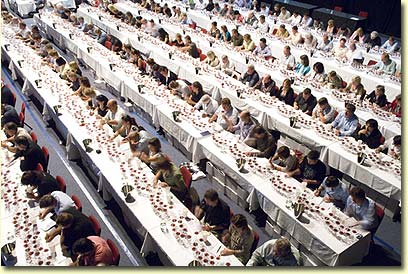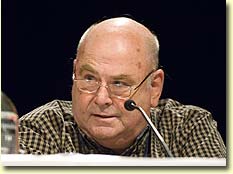
Each was selected to be a strong, representative bottle of a top-flight
pinot from their respective region. It was noted that for the U.S.
entry, the very ripe style was not included, and instead wines that were
made in a more Burgundian style were included. As the moderator stated,
“these are not Robert Parker wines.” The wines were not tasted blind,
and frankly I suspect this had some influence on the reactions of some
of the panelists. (Halliday and
Meadows
Photos Mark Coote ©

L: Michel Bettane, James Halliday, Bob
Campbell,
Poh Tiong Ch’ng, Matthew Jukes, Allen
Meadows
Photo
Mark Coote ©
My notes on the wines, in the order
presented:
2002 Arcadian, “Pisoni Vineyard” (Santa Lucia Highlands):
Restrained fruit, bit of leather and some floral notes; smells fairly
ripe. Bright cherry fruit palate, crisp acids, warm, medium body; clean,
simple; lingering finish. Rather closed and restrained, but fairly good. Find this wine
2003 Au Bon Climat, “Knox Alexander” (Bien Nacido Vineyard, Santa
Maria Valley): Riper with a slightly stewed element; deep cherry and
a bit of a stemmy herbaceous quality. Ripe rich palate, more complexity,
quite round and full bodied, some minerality and forest floor, good
length. A more complete wine, and more interesting. Find this wine
2003 Cristom, “Louise Vineyard” (Willamette Valley, Oregon):
Medium ripe fruit, slight medicinal/alcohol nose. Sharp, angular palate,
slightly bitter; leaner style with some tannins, a bit hard, low fruit
intensity but excellent structure, good length. This was essentially a
hard wine that needs considerable time for the fruit to emerge, but not
certain if there’s enough fruit to support the aging it needs. Could
simply be shut down. Find this wine
2003 Escarpment, “Kupe” (Martinborough, NZ): Complex herbal
fruit, quite open with some plums. Riper, friendlier style, quite
forthcoming with decent balance and good fruit; slightly hard mid-palate
with some acid poking out; a bit disjointed with some bitterness on the
finish. Nice, simpler style wine; needs a year to integrate. Find this wine
2002 Nuits St. Georges, “Boudots”, 1er Cru, Jadot: Taut, crisp
cherry fruit; clean, some ripeness, rather closed. Restrained palate but
velvety and round; complex, some tannin, good balance, fruit very
restrained, not much finish. Seems very young and in a shell at this
point, but quite good and should age very well. Find this wine
2003 Mt. Difficulty, “Target Gully” (Central Otago, NZ): Riper,
deeper; plummy with black fruits; complex nose. Quite rich palate, very
good, deep fruit; fairly tannic, moderately ripe, excellent depth and
balance, good long finish. Very complete wine with complexity and depth
in a riper style, but not overripe or heavy-handed in any way. Find this wine
2003 Paringa Estate (Mornington Peninsula, Australia): Slightly
candied nose with black fruit; deep, somewhat closed. Very ripe palate,
plush and rich fruit, big warm style, soft, full bodied with decent
balance; seems very ripe but not hot; good finish. Big ripe style of
pinot; well-made, not much complexity. A wine to drink young. Find this wine
2003 Chambertin, Grand Cru, Domaine Rousseau: Very ripe, slightly
roasted nose; deep and complex fruit. Soft entry followed by very deep,
clean fruit that builds in the mouth; not overripe or roasted, quite
rich, strong fruit but structure is apparent; round, long. Big ripe wine
with depth and complexity; very young. Find this wine
The comments of the panelists were interesting and, frankly, all over
the map. For example, Michel Bettane sharply criticized the Arcadian,
calling it “a poor wine, light, not interesting, no development,
leathery”. However, the other panelists liked the wine better, although
Allen Meadows stated that it was not a perfect example of the wine,
perhaps it had suffered a bit during shipping (apparently it had arrived
late, only a couple of days before beings served). Still, he liked the
wine, stating that like many good pinots, it had “power without weight.”
The ABC was also liked by most, although Bob Campbell thought it had a
“hole in the middle.” Bettane liked the Cristom very much (he has
written favorably about this winery in the past), as did Campbell, but
Poh Tiong Chng did not, finding it
dull, and Matthew Jukes felt was not
as balanced as the other two American wines. Everyone liked the Mt.
Difficulty, ranking it close to (although behind) the Chambertin in
overall preference. The Escarpment was generally liked although not a
standout, and the same was true of the Paringa. The Jadot was also
controversial, with Bettane stating he thought it was a bad bottle, and
Ch’ng finding it overextracted, but Jukes and Meadows liked it, although
Meadows believed it was completely shut down. Everyone loved both the
Mt. Difficulty and the Chambertin, with Bettane going so far as to call
the Mt. Difficulty “great”, and indicative that the vineyard was a great
terroir for pinot noir. Allen Meadows stated that the Chambertin
“exceeded my expectations” in light of the very difficult vintage
conditions in Burgundy in 2003. And indeed the wine did not show any
adverse effects from the extreme heat, coming across as a typical
top-notch Grand Cru from a “normal” year.
Overall I liked all of the wines quite a bit. My favorites were the
Chambertin, Mt. Difficulty, Jadot, and the ABC, in roughly that order.
Each one showed a great deal of character and depth, with complexity and
plenty of room for development. The other four wines were good pinots,
but seemed to be simpler and more straightforward, without the
complexity and depth of the others, and are clearly ready to drink
sooner. The most interesting aspect of this tasting, however, was that I
think there were no clear distinctions to be made based upon the origin
of the wines. Had the tasting been blind, I would not have much
confidence that I could accurately pick out the French wines from the
New Zealand, the U.S. wines from the Australian. In all of the wines,
the pinot noir character of the wine overshadowed any regional or
terroir-based distinctions. Perhaps with more bottle age, these
differences would become more apparent. At the very least, the tasting
demonstrated that New Zealand pinot noir deserves to be considered a
strong player on the world stage. We can no longer use the term “New
World” pinot to simply mean California and Oregon—New Zealand pinot is
right there, and coming on strong. NEXT: Grand Tasting—Other
Notable New Zealand Pinots
Bennett Traub
Reporting From New Zealand
Send Bennett an email
Introduction |
Terroir |
8 Great Producers |
Pinots of the World | Other Notable Pinots |
Conclusion



 The
final seminar
of Pinot 2007 was a tasting of 8 pinots from 4 different
countries. Included were three wines from the U.S. (2 from California, 1
from Oregon), two wines from France, two wines from New Zealand, and one
from Australia. The wines were selected by panelists from each country,
so that Allen Meadows (below, right helped
select the U.S. wines, Michel Bettane
the French, and James
Halliday (left) the Australian pinot.
Bob Campbell, MW, a leading authority
on New Zealand wines (and a Kiwi himself) selected the New Zealand
pinots.
The
final seminar
of Pinot 2007 was a tasting of 8 pinots from 4 different
countries. Included were three wines from the U.S. (2 from California, 1
from Oregon), two wines from France, two wines from New Zealand, and one
from Australia. The wines were selected by panelists from each country,
so that Allen Meadows (below, right helped
select the U.S. wines, Michel Bettane
the French, and James
Halliday (left) the Australian pinot.
Bob Campbell, MW, a leading authority
on New Zealand wines (and a Kiwi himself) selected the New Zealand
pinots.
